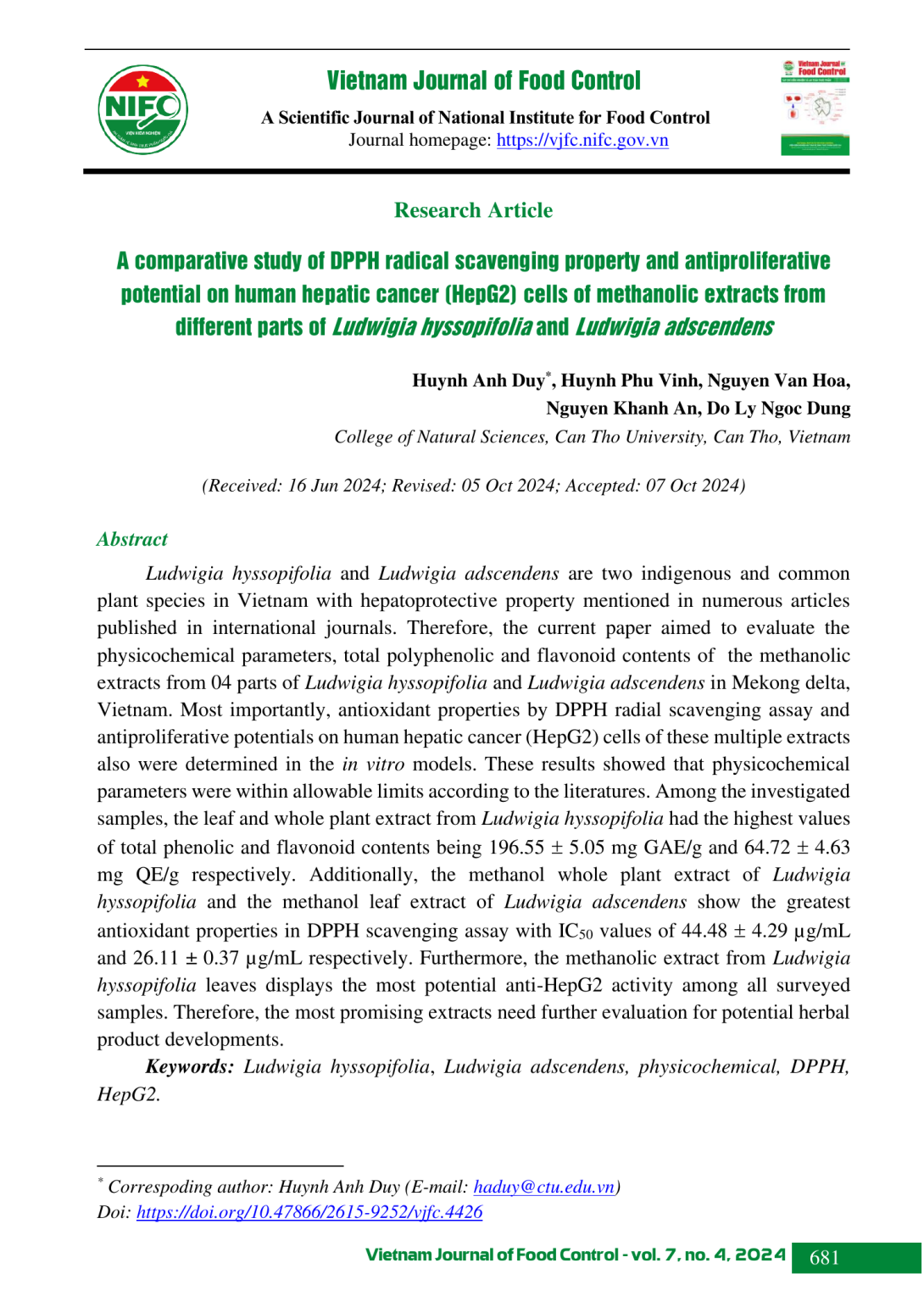
Rau mương thon (Ludwigia hyssopifolia) và Rau dừa nước (Ludwigia adscendens) là hai loài thực vật bản địa và gặp phổ biến ở Việt Nam, có đặc tính bảo vệ gan và đã được đề cập trong nhiều nghiên cứu ngoài nước. Trên cơ sở đó, bài báo này nhằm xác định các thông số lý hóa của bột dược liệu, hàm lượng polyphenol và flavonoid toàn phần có trong các cao chiết methanolic từ 04 bộ phận của Ludwigia hyssopifolia và Ludwigia adscendens ở đồng bằng sông Cửu Long, Việt Nam. Hơn nữa, đặc tính chống oxy hóa dựa trên thử nghiệm quét gốc tự do DPPH và tiềm năng ức chế tăng sinh dòng tế bào ung thư gan ở người (HEPG2) của các cao chiết này cũng được khảo sát trên thử nghiệm in vitro. Những kết quả cho thấy tất cả các đặc tính hóa lý của bột dược liệu đều nằm trong giới hạn cho phép theo các tài liệu tham khảo. Trong số các mẫu khảo sát, cao chiết lá và toàn cây từ Rau mương thon (Ludwigia hyssopifolia) có giá trị hàm lượng phenolic và flavonoid toàn phần cao nhất lần lượt là 196,55 ± 5,05 mg GAE/g và 64,72 ± 4,63 mg QE/g. Ngoài ra, cao chiết methanol từ toàn cây của Ludwigia hyssopifolia và cao chiết methanol từ lá của Ludwigia adscendens thể hiện đặc tính chống oxy hóa tốt nhất trên thử nghiệm DPPH với giá trị IC50 lần lượt là 44,48 ± 4,29 µg/mL và 26,11 ± 0,37 µg/mL. Đáng chú ý, cao chiết methanolic từ lá Rau mương thon (Ludwigia hyssopifolia) cho đặc tính ức chế HepG2 tiềm năng nhất trong số tất cả các mẫu được khảo sát. Do đó, các mẫu cao chiết tiềm năng nhất cần được đánh giá thêm để tạo cơ sở nhằm phát triển các sản phẩm từ thảo dược.
Ludwigia hyssopifolia and Ludwigia adscendens are two indigenous and common plant species in Vietnam with hepatoprotective property mentioned in numerous articles published in international journals. Therefore, the current paper aimed to evaluate the physicochemical parameters, total polyphenolic and flavonoid contents of the methanolic extracts from 04 parts of Ludwigia hyssopifolia and Ludwigia adscendens in Mekong delta, Vietnam. Most importantly, antioxidant properties by DPPH radial scavenging assay and antiproliferative potentials on human hepatic cancer (HepG2) cells of these multiple extracts also were determined in the in vitro models. These results showed that physicochemical parameters were within allowable limits according to the literatures. Among the investigated samples, the leaf and whole plant extract from Ludwigia hyssopifolia had the highest values of total phenolic and flavonoid contents being 196.55 5.05 mg GAE/g and 64.72 4.63 mg QE/g respectively. Additionally, the methanol whole plant extract of Ludwigia hyssopifolia and the methanol leaf extract of Ludwigia adscendens show the greatest antioxidant properties in DPPH scavenging assay with IC50 values of 44.48 4.29 μg/mL and 26.11 ± 0.37 μg/mL respectively.Furthermore, the methanolic extract from Ludwigia hyssopifolia leaves displays the most potential anti-HepG2 activity among all surveyed samples. Therefore, the most promising extracts need further evaluation for potential herbal product developments.
- Đăng nhập để gửi ý kiến
